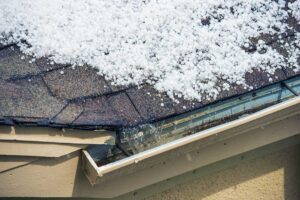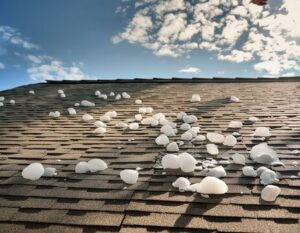How to Spot Hail Damage: A Guide Before You Search for Hail Damage Repair Near Me
Hailstorms can be sudden and unpredictable, leaving significant damage to your roof, siding, and other parts of your home. When hail strikes, it may not always be immediately obvious, especially from the ground. However, spotting hail damage early can save you from more extensive repairs down the line. This guide will help you identify the signs of hail damage on your roof and explain why it’s important to address these issues promptly.
Understanding Hail Damage
 Hail damage occurs when small or large balls of ice fall from the sky during a storm. Depending on the size of the hailstones, they can vary in severity, leaving behind marks or causing cracks in roofing materials. When hail strikes your roof, it impacts the shingles or tiles, leading to a variety of potential issues, including leaks, compromised shingles, and weakened roofing systems. Identifying hail damage early is crucial because if left untreated, it can lead to more serious problems like water damage, mold, and structural instability.
Hail damage occurs when small or large balls of ice fall from the sky during a storm. Depending on the size of the hailstones, they can vary in severity, leaving behind marks or causing cracks in roofing materials. When hail strikes your roof, it impacts the shingles or tiles, leading to a variety of potential issues, including leaks, compromised shingles, and weakened roofing systems. Identifying hail damage early is crucial because if left untreated, it can lead to more serious problems like water damage, mold, and structural instability.
Common Signs of Hail Damage on Your Roof
Inspecting your roof after a hailstorm is the best way to detect damage. Start by looking for common signs of wear and tear. First, check your gutters and downspouts for granules. Roofing shingles, especially asphalt ones, have protective granules that can be dislodged by hail. If you find these granules in your gutters, it’s a sign that your shingles may have been damaged.
Next, examine the shingles themselves. Hail damage may leave behind dents or bruises, which can be subtle and difficult to spot from the ground. You may also notice cracks, splits, or missing sections. Hail can cause these shingles to lift or even break, leaving your roof vulnerable to water penetration.
Another sign of hail damage is a change in the color of the shingles. Over time, hail can remove the protective layers, causing the shingles to fade or change in appearance. If your shingles appear darker or have areas of discoloration, it could be an indication of hail damage that needs attention.
How to Conduct a Roof Inspection Safely
While it’s essential to check for signs of hail damage, your safety should always be a top priority. If you are comfortable doing so, you can inspect your roof using a ladder. Make sure the ladder is placed on a stable surface, and consider having someone hold it for extra safety. Alternatively, you can use binoculars from the ground to look for any visible signs of damage, especially around the edges of the roof or any higher points.
For those who are not comfortable with roof inspections or do not have access to safe equipment, it’s always a good idea to call in a professional roofing contractor. Many roofing companies offer free inspections, and they have the proper training and tools to thoroughly assess the damage without putting themselves at risk.
Identifying Hail Damage on Different Roofing Materials
Hail can impact various roofing materials differently. Asphalt shingles, for example, may show indentations or missing granules. Metal roofing, on the other hand, may have dents or dings, which can sometimes be challenging to spot unless viewed closely. Slate or tile roofs might crack or chip upon impact, while wooden shakes can split or break under severe conditions.
It’s important to understand the specific vulnerabilities of your roof’s material. Each type of roof reacts differently to hail, so getting an expert’s opinion may be crucial in determining the extent of the damage and whether repairs or replacement is necessary.
The Importance of Timely Hail Damage Repairs
Ignoring hail damage can lead to far more severe consequences. Once the roofing materials have been compromised, water can seep into your home, leading to leaks, mold growth, and structural issues. In some cases, minor hail damage may not be immediately noticeable but can worsen over time. The longer you wait to repair hail damage, the more costly the repairs may become.
In addition to preventing further damage, timely repairs may also help you retain your roof’s warranty. Many manufacturers require homeowners to make prompt repairs to qualify for full warranty coverage. If you delay, you might find that your warranty no longer covers the damage, leaving you responsible for the cost of repairs.
Why You Should Call a Professional for Hail Damage Repair
E ven if you believe you’ve spotted hail damage on your roof, it’s always wise to call a professional roofing contractor to perform a thorough inspection and provide an accurate assessment. Roofs can sometimes hide damage that isn’t visible to the untrained eye. A professional will be able to spot the signs of impact that may not be immediately noticeable.
ven if you believe you’ve spotted hail damage on your roof, it’s always wise to call a professional roofing contractor to perform a thorough inspection and provide an accurate assessment. Roofs can sometimes hide damage that isn’t visible to the untrained eye. A professional will be able to spot the signs of impact that may not be immediately noticeable.
Additionally, working with an experienced contractor ensures that repairs are done properly. A professional roofer will have the necessary skills, tools, and materials to restore your roof to its pre-storm condition, ensuring that your home remains protected from the elements.
What to Do After Spotting Hail Damage
Once you’ve identified potential hail damage, it’s essential to take quick action. Start by contacting your insurance company to report the damage. Many policies cover hail damage, but it’s crucial to document the extent of the damage before starting repairs. Take photographs of the affected areas to submit with your claim.
Next, reach out to a reputable roofing contractor who specializes in hail damage repairs. They will guide you through the process, from assessing the damage to working with your insurance company to ensure that repairs are covered.